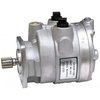- Joined
- Apr 9, 2010
- Messages
- 1,190
- Display Name
Display name:
Llewtrah
Right now my Warrior is in Annual and the vacuum pump has 425 hours on it (in 2 years). Chatting with the shop, they don’t recommend replacing it right now, even though there will likely be about 700 hours on it at next year’s Annual. I agree with that but also don’t want to get stranded on the road if I can avoid it. With the kind of trips I’ve been doing (plus the AI and DG being overhauled last summer and all the vac lines and filters replaced) I suspect it’ll make it to 700 hours as is.
I’ve heard of (and seen) people carry a spare pump with them. Any sense of the “shelf life” of these, new and rebuilt? I don’t want to carry one for nearly a year just to have it die after a few hours if I need it on the road. I’d have it put in at next Annual if not used. In hindsight, the last one went about 700 hours and was working fine when replaced due to hours.
I still use steam gauges and am happy with that.
I’ve heard of (and seen) people carry a spare pump with them. Any sense of the “shelf life” of these, new and rebuilt? I don’t want to carry one for nearly a year just to have it die after a few hours if I need it on the road. I’d have it put in at next Annual if not used. In hindsight, the last one went about 700 hours and was working fine when replaced due to hours.
I still use steam gauges and am happy with that.









